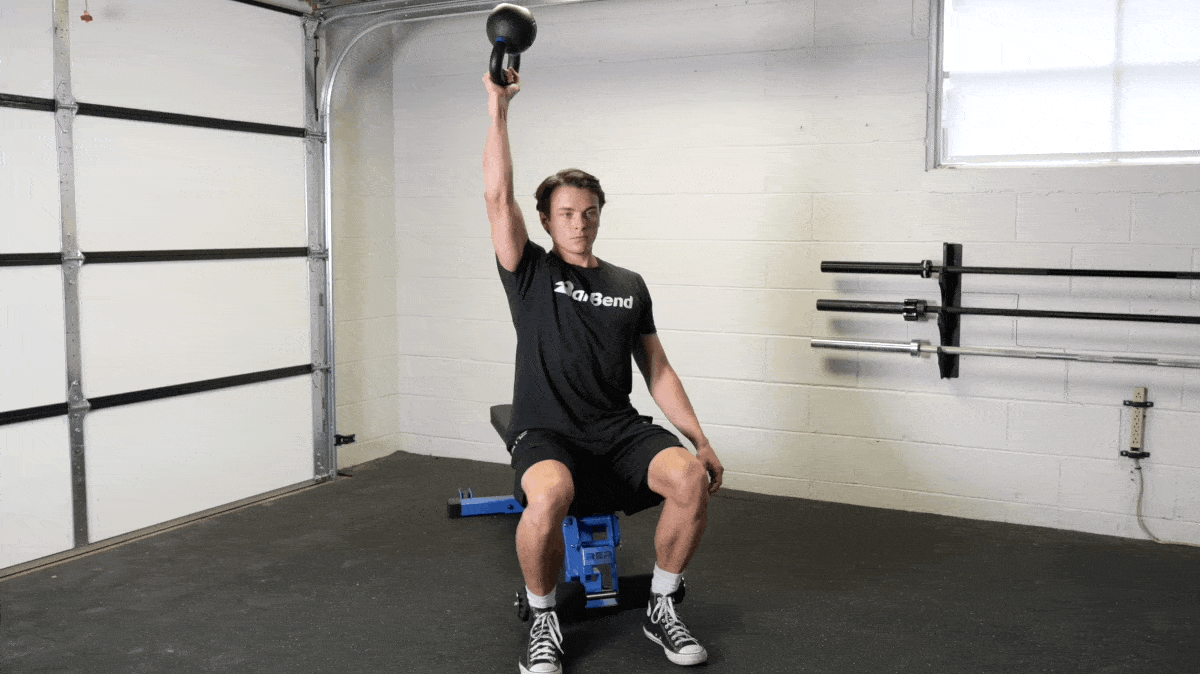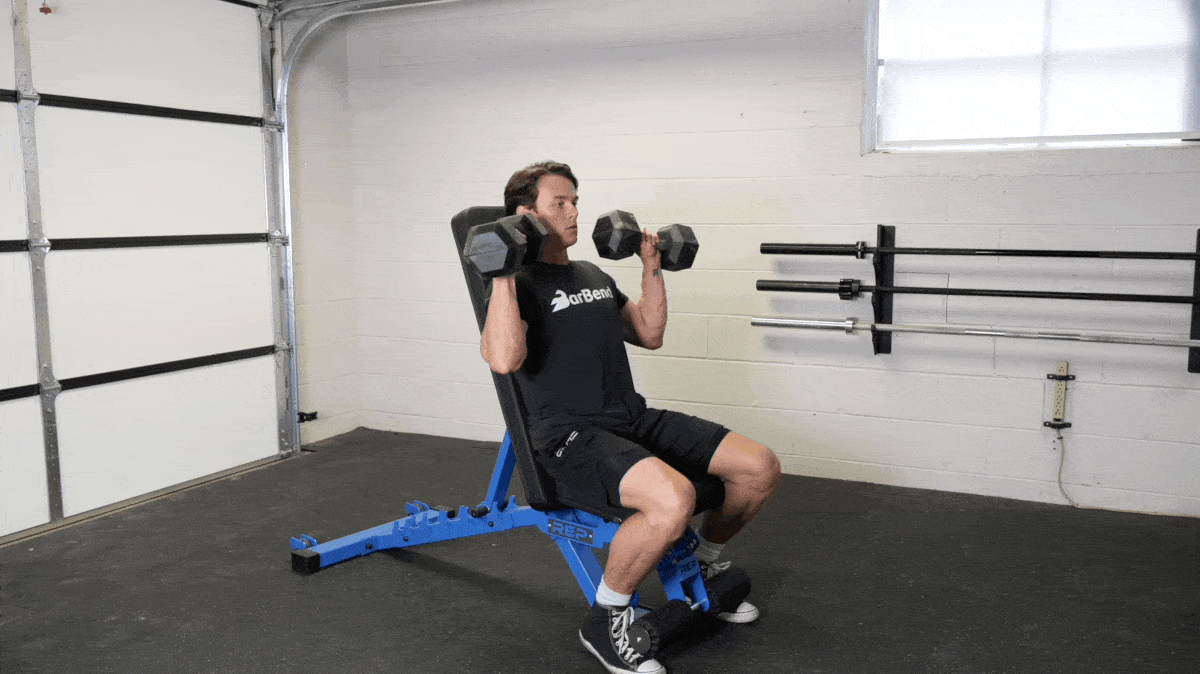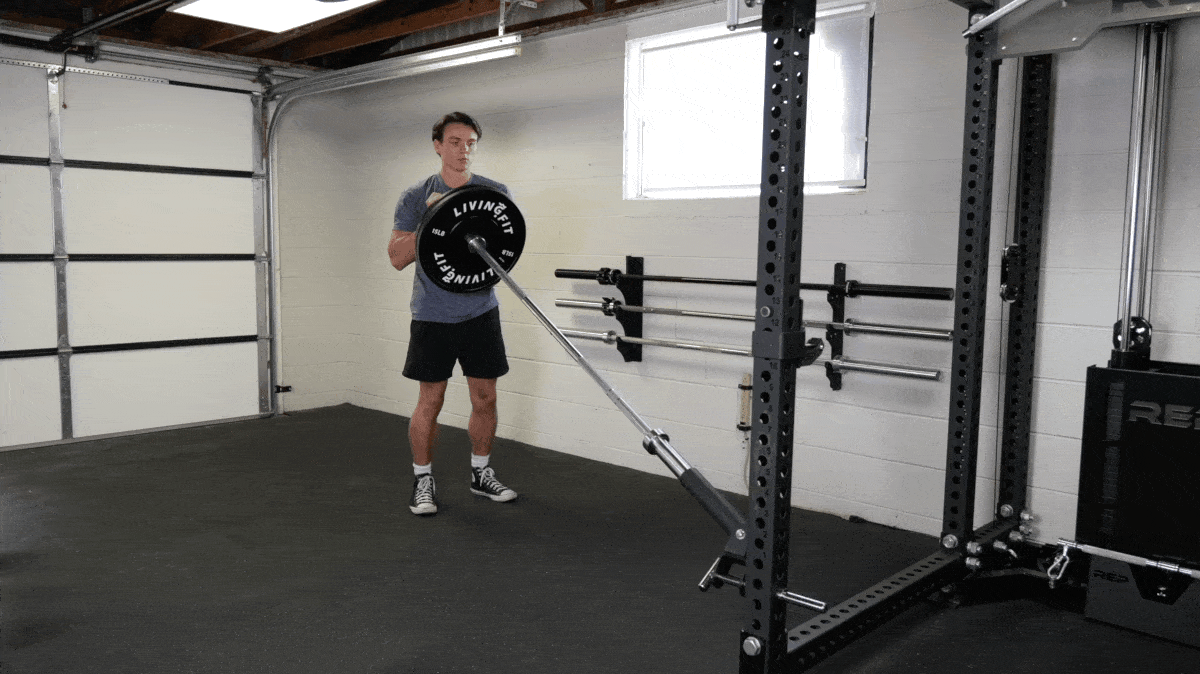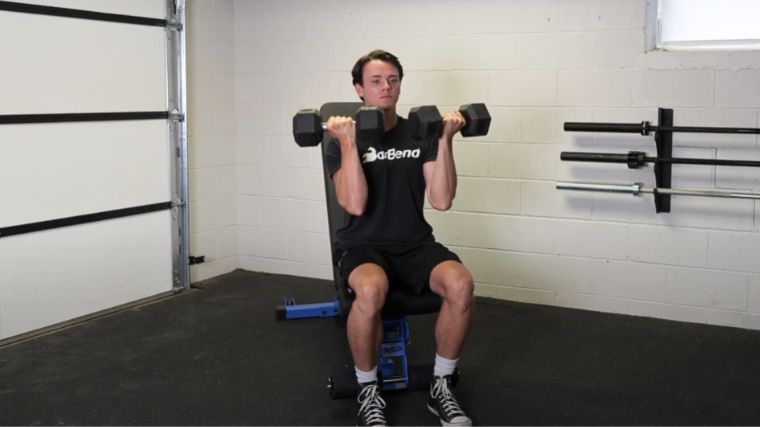The Arnold press is a classic shoulder-building exercise made famous by none other than its namesake, seven-time Mr. Olympia winner Arnold Schwarzenegger. The seated Arnold press is a variation of the dumbbell shoulder press, and you’ll want to add it to your repertoire when you’re looking for bigger, stronger delts that will pop the sleeves of any shirt. The Arnold press takes your muscles through a fuller range of motion than the ordinary dumbbell press. And, unlike the traditional version, the Arnold gives you a way to hit all three heads of the deltoids. That’s huge for when you want to build broad shoulders — like Arnold himself.
How To Do the Arnold Press

- Set Up: Grab a pair of dumbbells, one in each hand. Sit down at the end of a weight bench. Hold the dumbbells slightly in front of you, at face height. Keep your palms facing you.
- Rotate and Press: Press the dumbbells overhead while simultaneously rotating your palms so that they’re facing forward. When the dumbbells lock out overhead, your palms should be facing away from you.
- Reverse It: Lower the weights slowly. Simultaneously rotate your palms so that they face towards you at the bottom of the movement.
Coach’s Tip: The key to the Arnold press is to smoothly press the weights upward while rotating your arms. Don’t twist your arms and then press; do both at the same time.
Arnold Press Variations
The Arnold press is a pretty unique overhead exercise. Since it is highly unique, there aren’t too many variations out there. But, they do exist and are worth considering when you want to hone in on your gains.
Partial ROM Arnold Press
[Read More: The 15 Best Shoulder Exercises for Building Muscle]
- Set up as you would for a standard Arnold press.
- Press and rotate the weights up, stopping just after the weights you’re using pass eye level.
- Pause for a moment at the top and return them to the starting position.
Doing the bottom half of the Arnold press will emphasize only your shoulders, removing your triceps from the movement almost entirely. Do this one if you want to preserve your arm strength or are limited in your overhead mobility.
Tempo Arnold Press
[Read More: The 10 Best Shoulder Press Variations for Broader Delts]
- Perform a standard Arnold press, whether in a half-kneeling position as shown above, or seated against an adjustable weight bench.
- Deliberately slow down your lifting tempo, taking two seconds to press the weight up and three full seconds to lower it back down.
Tempo training can help you get in tune with the muscles you’re trying to work. Do the tempo Arnold press as part of your warm-up, or if you’re new to the exercise and need to master the technique.
Arnold Press Alternatives
If the Arnold press isn’t doing it for you, but you want something similar, you’re in luck. Here are a couple of alternatives to the Arnold shoulder press that work the muscles in a similar fashion.
Bottoms-Up Kettlebell Press

[Read More: Standing vs. Sitting Dumbbell Shoulder Press]
- Sit upright on a bench or plyo box with no back support and hold a kettlebell inverted in your working arm.
- From here, brace your core and sit tall, then press the weight up overhead, rotating your arm if you desire.
- Lower the weight back down with a nice slow tempo.
This exercise doubles down on the inherent instability of the Arnold press. You can use this one if you really want to emphasize shoulder stability and don’t care as much about pressing big weights.
Seated Dumbbell Shoulder Press

[Read More: How To Do the Alternating Dumbbell Press (+ the Best Variations for Muscle and Strength)]
- Sit upright in a low bench or adjustable weight bench with a pair of dumbbells on your knees.
- “Kick” off the ground with each leg to pop the weights up to your shoulders.
- From here, press the weights upward until your arm fully extends overhead.
The standard seated shoulder press is a good option if you want to prioritize heavy weights for more muscle growth or strength. Do this one if the Arnold press is too complicated for you, or if you find the rotational aspect awkward or uncomfortable.
Side-to-Side Landmine Press

- Stand upright facing a barbell that has been wedged into a landmine base.
- Pick the end of the bar sleeve up and clasp it at chest-level in your palms.
- Press it up and outward in front of you.
- Lower it down to one side of your body, pause, then press it up and lower it down on the other side.
This exercise is a good substitute if you want to work your shoulders through multiple planes of motion but can’t do a strict overhead movement. The side-to-side landmine press requires less shoulder mobility and will still train your stability and core strength.
Who Should Do the Arnold Press
The Arnold press isn’t likely going to become your main shoulder strength exercise, but that doesn’t mean it’s not a valuable add-on to many a training program. Athletes with a wide variety of training protocols and goals would be well-served by adding this lift to their accessory moves.
Bodybuilders
Achieving well-rounded shoulders isn’t just a goal for bodybuilders — it’s a competition necessity. The Arnold press is an effective lift to add to a bodybuilder’s repertoire precisely because it’s so efficient. It targets all three heads of the deltoid at once, encouraging more symmetrical growth without adding three separate moves to a routine.
Strength Athletes
Whether you’re a weightlifter or a strongman athlete, you’ve got overhead lifts in your competitions. Because the Arnold press adds both volume and precision to your overhead training, it won’t just help you build all-around shoulder mass. It’ll also help increase the stability and strength of your rear delts in pressing movements. This move can also be a good way for strength athletes to develop muscle tissue in overhead movements with less loading relative to strict pressing. All of this can carry over into stronger competition lifts without too much extra strain.

[Read More: Arnold Schwarzenegger’s Arm Workout, Explained and Remixed for All Experience Levels]
Even powerlifters can benefit from this move. They might not have any vertical pressing in competition, but it behooves powerlifters to have a strong, stable set of delts. The Arnold press accomplishes this while not encouraging lifters to go so heavy that they’ll interfere too much with bench press recovery.
Recreational Lifters
Regular gymgoers can benefit from the Arnold press as it can help increase shoulder strength, muscle mass, and attack all three heads of the deltoids at once. If you are limited in time and want stronger, broader shoulders, the Arnold press can give you the efficient one-two punch you’re looking for.
Arnold Press Sets and Reps
Performing the Arnold press can help you get stronger, but it’s not the best option for pure pressing strength. That’s because its wide range of motion and fine movements around your shoulder joints can become tricky with heavy loads. Instead, use the Arnold press to supplement your shoulder routine through muscle-building and endurance.
- For Muscle-Building: Perform 2 to 4 sets of 8 to 12 reps, approaching failure toward the end.
- For Endurance: Do 3 or 4 sets of up to 20 reps with a light weight and limited rest.
Benefits of the Arnold Press
The Arnold press is all about building size and definition in your shoulders. Using it can help get you that much closer to matching those Arnold posters you had in your room when you were a teenager.
Train Multiple Heads of the Deltoids at Once
Unlike the regular dumbbell shoulder press, the Arnold press adds in a rotation. This increases the demands on the rear delts. By starting with your elbows in front of the body and then moving them outwards as you press upwards, you horizontally abduct the shoulder. That process targets your rear delts. This modification makes an already middle and front delt exercise even more effective at targeting all three heads of the shoulders.
[Read More: Try These Dumbbell Shoulder Workouts to Build Strength]
Why does that matter? Simple answer: boulder shoulders. The more attention you pay to all aspects of your shoulders, especially your oft-neglected rear delts, the bigger and broader your shoulders can become.
Increased Range of Motion
During regular shoulder presses, you’ll often lower the weights to chin level or to the point where the dumbbells touch the tops of the shoulders. In the Arnold press, the dumbbells not only are lowered to the shoulders, or even slightly lower, your hands are also rotated so that your palms face your face at the bottom.
[Read More: Try This Shoulder and Biceps Workout to Build Muscle]
This increases the range of motion of the movement. Increasing the range of motion means you are hitting more muscles. You can then have very effective workouts with less weight needed when compared to the overhead press.
Muscles Worked by the Arnold Press
Primarily, the Arnold press will — like all overhead movements — place a major emphasis on your shoulders. Like all pressing movements, both horizontal and vertical, this move will also call on your triceps for a major assist.
Deltoids
The shoulder has three main heads; the front, middle (or lateral), and rear deltoid. Most shoulder pressing movements only target the front and middle delts. The innovation of the Arnold press lies in its rotation and shoulder abduction at the bottom of the movement — that’s how this move goes a step further and brings your rear delts into the fold.

In fact, some scientific studies have shown that the Arnold press elicits more muscle activation in your shoulder than a standard shoulder press, even if you do use less weight. (1) This means more bang for your training buck, and better results along the way.
Triceps
Your triceps also come out to play in the elbow extension phase of the Arnold press — when you’re pressing up. As with other pressing moves, your triceps will work indirectly to help you achieve lockout at the top of the lift.
Common Arnold Press Mistakes
The Arnold press is a great move to use — it looks really cool, and it’s named after quite the legend. But you need to know what you’re doing to get the most out of it.
Using Too Much Weight
It might be tempting to load up the Arnold press as heavy as you possibly can. But generally speaking, you want to avoid loading this lift as heavily as you would for regular dumbbell presses. Since you’ll be rotating your palms throughout the range of motion, using extremely heavy weights might jeopardize your shoulder health and integrity. Instead, focus on using this move as a muscle-builder and an accessory lift for building endurance.
Using Too Little Weight
Sure, you don’t want to go too heavy — but you don’t want to lose out on the gains, either. Make sure you’re using enough weight to be approaching failure toward the end of your sets and reps. Breezing through this lift will leave potential muscle growth on the table. So take your time finding the right weight through gradual progressive overload.
Not Rotating Enough
Don’t let the Arnold press become a regular dumbbell press. If you don’t focus — or if you’re loading up too heavy — you might neglect to bring your palms back to facing you between each rep. This can also happen if you’re rushing to push through the next rep instead of taking the time you need to reset between each one. Without full rotations, this move loses the benefits of working all three heads of your delts. And without that, you might as well be performing regular dumbbell presses.
FAQs
This will depend on your individual limb length and shoulder mobility. In general, though, you want to try to keep your arms perpendicular to the floor and parallel to each other. Too narrow and you will feel your front shoulders too much. Go too wide, and the weights will feel like they will be falling out the sides.
The Arnold press is not a strength movement that you should be training to max weights. However, you can still train it with heavier loads in the eight to 12 rep range, taking it toward failure with controlled movements.
Yes. You can do this move seated or standing. Sitting down will allow you to keep most of the emphasis on your shoulders because it takes out any assistance, even minor assistance, from the rest of your body. You can stand up if you want to recruit more of your core for stability purposes — but just make sure to squeeze your quads and glutes to avoid overextending your lower back.
Reference
- Raizada, Shiny & Bagchi, Amritashish. (2017). Comparison among the EMG Activity of the Anterior Deltoid and Medial Deltoid During Two Variations of Dumbbell Shoulder Press Exercise. Indian Journal of Public Health Research & Development. 8. 653. 10.5958/0976-5506.2017.00411.9.